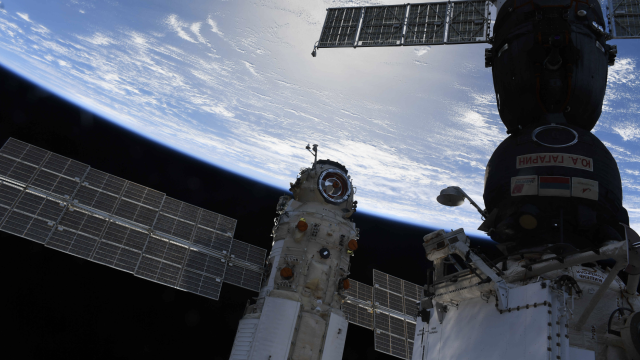Disaster nearly struck the International Space Station last week when a Russian module unexpectedly fired its thrusters shortly after docking. A retired space engineer is now sounding the alarm, saying NASA’s safety culture is showing signs of decay and that an independent investigation is necessary.
James Oberg is not one to hold back.
The retired “rocket scientist” and mission controller worked at NASA from 1975 to 1997, where he served as an expert on orbital rendezvous. His expansive knowledge of the Russian and Chinese space programs has led him to testify before Congress on several occasions, and his 2002 book, Star-Crossed Orbits, exposed the shortcomings that existed in the U.S.-Russian relationship while the ISS was under development.
Naturally, the recent incident with the ISS caught Oberg’s attention, prompting him to write a guest post for IEEE Spectrum.
“While the proximate cause of the incident is still being unravelled, there are worrisome signs that NASA may be repeating some of the lapses that lead to the loss of the Challenger and Columbia space shuttles and their crews,” he wrote. “And because political pressures seem to be driving much of the problem, only an independent investigation with serious political heft can reverse any erosion in safety culture.”
Indeed, it’s arguably the most serious incident to have occurred on the International Space Station. On July 29, Russia’s Nauka module successfully docked at the orbital outpost, and for a while all seemed well. As cosmonauts worked to integrate the newly arrived module, however, Nauka’s thrusters began to fire, causing the space station to roll backwards at a rate of 0.5 degrees per second. No one knew this was happening until an on-duty flight controller at NASA noticed the station’s changing orientation. Thrusters on the ISS worked to counter the unexpected propulsion, and finally, after Nauka’s thrusters suddenly stopped, control was restored.
NASA insists that astronauts aboard the ISS were never in any danger, but as Oberg writes: “How close the station had come to disaster is an open question, and the flight director humorously alluded to it in a later tweet that he’d never been so happy as when he saw on external TV cameras that the solar arrays and radiators were still standing straight in place.” Oberg is finding no humour in any of this, especially when considering that this incident resulted in the first-ever declaration of a “spacecraft emergency” in the station’s history.
The ISS seems to be ok, but stresses caused by the unexpected rotation could have affected the modules, support girders, solar arrays, radiator panels, and robotic arms. Still, the exact details of what happened that day are not yet fully known. The media has “depicted teams of specialists manually directing on-board systems into action, but the exact actions taken in response still remain unclear — and probably were mostly if not entirely automatic,” Oberg writes. That NASA initially reported a spin of 45 degrees and not the actual spin of 540 degrees is not a good look, he argues.
As Oberg also points out, the space agency, instead of speaking critically about the incident, is instead reminding everyone of the awesomeness that is the working relationship between NASA and Roscosmos. The emphasis on maintaining a good relationship with Moscow — so, politics — appears to be getting in the way of safety. But what’s also getting in the way of safety, he says, is, ironically enough, a dearth of serious incidents in recent history.
“The bureaucratic instinct to minimise the described potential severity of the event needs cold-blooded assessment,” Oberg writes. “Sadly, from past experience, this mindset of complacency and hoping for the best is the result of natural human mental drift that comes when there are long periods of apparent normalcy.” To which he adds: “The NASA team has experienced that same slow cultural rot of assuming safety several times over the past decades, with hideous consequences.”
Oberg said a complacent culture existed at NASA in the years leading up to the 1986 Challenger disaster, a time when he worked at Mission Control. Team members had “noticed and begun voicing concerns over growing carelessness and even humorous reactions to occasional ‘stupid mistakes,’ without effect,” writes Oberg. A similar “mental drift” took hold in the late 1990s during joint U.S.-Russian operations on Mir and during early ISS flights, he says.
NASA headquarters, or some other higher office, should intervene to “reverse the apparent new cultural drift,” Oberg writes. He is calling for an independent investigation into the incident to determine the exact cause and to expose the decision-making that took place at NASA that allowed Nauka to dock — a module that Russia was unable to disarm in the event of an emergency.
Like NASA, Roscosmos has also downplayed the incident. Sergei Krikalev, the director of crewed space programs at Roscosmos, said an investigation will be launched to assess the physical impact of the mishap on the ISS, but the extent of this investigation is not known. It appears that both NASA and Roscosmos are hoping to brush this incident under the carpet, but as Oberg points out, it should serve as a much needed wake-up call.
